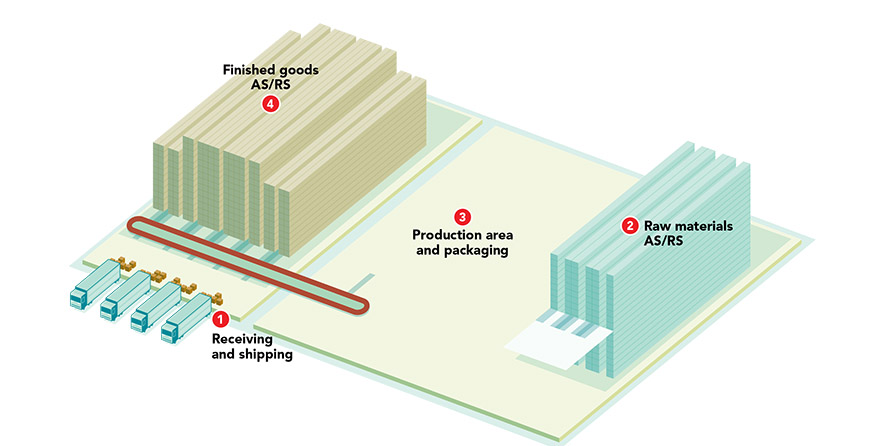S.narendrakumar & Co. (Everest)
Umbergaon, Gujarat, India
Square Footage: 400,000 square feet
Products Handled: Spices and dried fruit
SKUs: 45 different products offered in 200 different sizes
Throughput: Processes 400 tons of product a day
S.narendrakumar & Co.’s new factory and warehouse in Umbergaon, Gujarat, uses two automated storage and retrieval systems (AS/RS) to manage raw materials that go into the spice blending process and the storage of finished goods prior to shipment.
To minimize the footprint, the factory operates on two levels. Production takes place on the second floor while receiving, warehousing and shipping operations take place on the ground level.
Read the June 2018 Cover Story on the S.narendrakumar & Co Case Study
Raw materials receiving: Incoming raw materials arrive in bulk bags that are floor loaded on trucks. Pallets are only used for internal operations. Following a security check, trucks arrive at a dock (1) where a receiving manager verifies the purchase order and weight of the material. Random bags are cut open for a chemical and visual quality control inspection. Once the check-in process is complete, the bagged material is unloaded onto pallets for putaway into the raw materials AS/RS system (2). Each SKU has its own palletizing pattern.

Storage into the raw materials AS/RS: Once a pallet is complete, the load is secured to the pallet with straps to keep the bulk bags in place as they move through the facility. At present, there is no automatic link between the Daifuku system and the enterprise resource planning system, so identifying information is manually entered into the system to create a bar code label for the material on the pallet. Once applied, the bar code and the license plate bar code label are scanned to marry the product to that pallet. The system then directs a lift truck operator to one of three induction stations on the ground floor level (2). There, the pallet is weighed and scanned for a dimension check. If those are both within tolerances, the pallet is delivered by conveyor to a pick-up station and a crane puts it away into storage. That pallet is now available for production.
Retrieval from the raw materials AS/RS: Production plans are created a day before the production run. Once the plan is created and entered into an automated production system, a bill of materials is sent to the warehouse management system (WMS) to coordinate retrieval from the AS/RS. Pallets are retrieved by the system on a strict first-in/first-out basis and delivered to a pickup location on the second floor, where the processing and blending of spice mixtures takes place. A lift truck operator delivers pallets to a staging location in the production area (3), which also serves as a pick location. Operators feed raw materials into the hopper or machine as needed. If a pallet isn’t depleted and can be used the next day, it stays in its picking location. Otherwise, the system creates a new license-plate bar code that accurately reflects the amount of raw material left on the pallet before it is put back into the AS/RS for storage. Empty pallets are delivered to the receiving area, where they are stored until needed in a pallet stacker.
Finished goods receiving: Finished goods are automatically packaged in their shelf ready, or primary packaging. They are then manually packed into transport, or secondary packaging. Once a carton is sealed, a UPC bar code label is manually applied and the carton is stacked onto a storage pallet. Cartons are manually scanned and married to the pallet. A lift truck operator delivers the pallet to an induction station for the STV system. Once the pallet is weighed and dimension checked, the STV delivers it to pallet conveyor in front of the AS/RS (4). It is then picked up for putaway by one of three cranes. The system will be expanded to five cranes by November 2018.
Finished goods retrieval: Trucks get dispatch data the day before pickup and begin arriving at the facility the next day. Once an incoming, empty truck is checked in, it is directed to an available dock. Meanwhile, the AS/RS pulls the material needed for that truck. The pallet-staging area in shipping also serves as the picking location. Cartons are picked as needed for the order—and only full cartons are picked—and placed onto a telescoping conveyor that delivers them into a trailer. Cartons are floor loaded; pallets always stay within the facility.
System suppliers
SYSTEM DESIGN AND INTEGRATION, (including two AS/RS systems, Sorting Transfer Vehicles, conveyor and warehouse control and management systems): Daifuku
LIFT TRUCKS: Yale
Article topics








